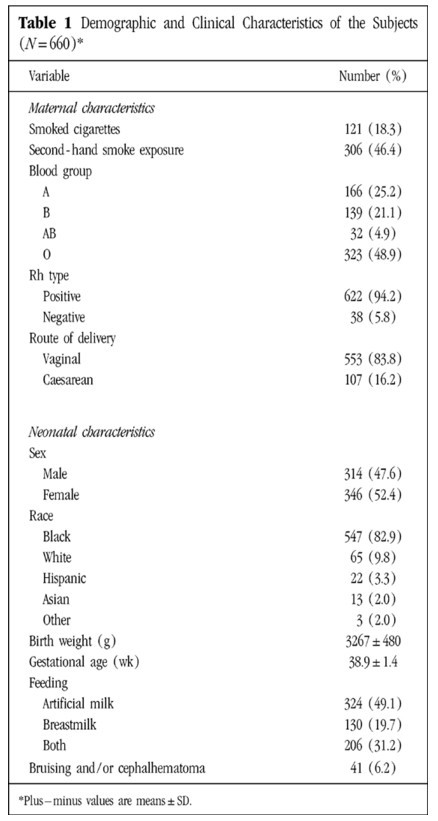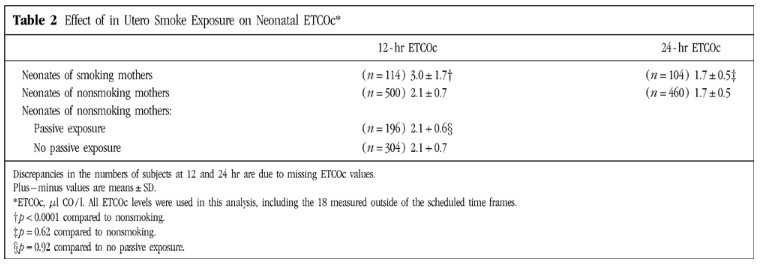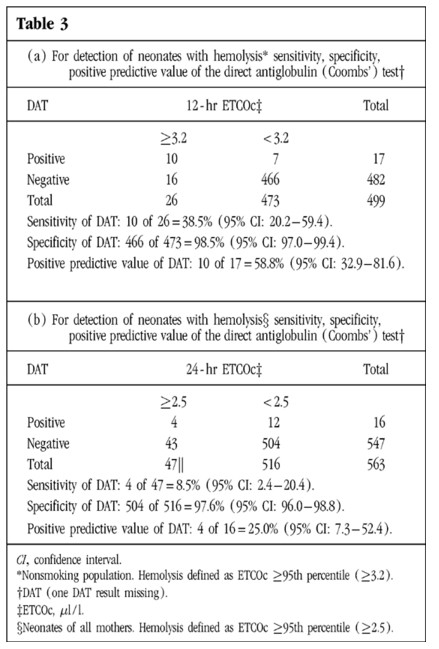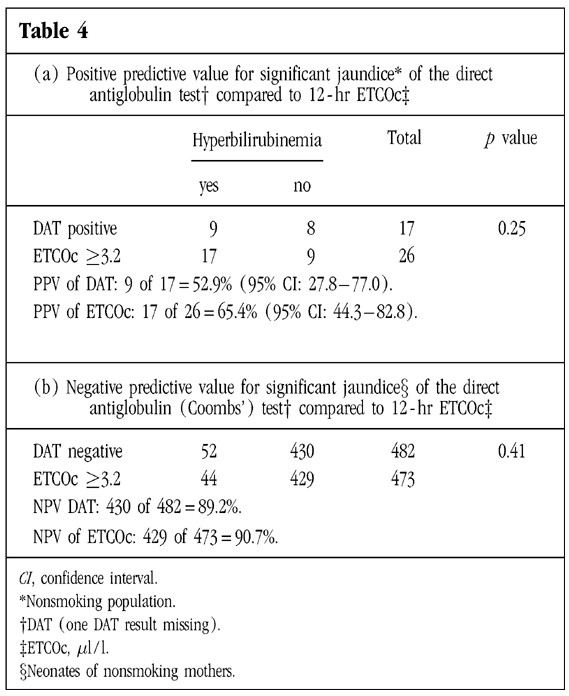Evaluation of the Direct Antiglobulin (Coombs') Test…
Evaluation of the Direct Antiglobulin (Coombs') Test for Identifying Newborns at Risk for Hemolysis as Determined by End-Tidal Carbon Monoxide Concentration (ETCOc); and Comparison of the Coombs' Test With ETCOc for Detecting Significant Jaundice
Marguerite Herschel MD, Theodore Karrison PhD, Ming Wen MS, Leslie Caldarelli MD & Beverly Baron MD
OBJECTIVE: First, to determine the sensitivity, specificity, and positive predictive value (PPV) of the direct antiglobulin test (DAT) for significant hemolysis in the neonate, as referenced to end-tidal carbon monoxide, the criterion standard for estimating the rate of hemolysis; and second, to evaluate the predictive value of the two procedures for significant jaundice.
Journal of Perinatology volume 22, pages341–347(2002)Cite this article
DESIGN: Consecutive term newborns admitted to the nursery of an inner-city university hospital over a 15-week period. DAT screening by the Blood Bank was performed on all. End-tidal carbon monoxide levels were obtained at 12±6 and at 24±6 hours of age. Infants of nonsmoking mothers whose 12-hour exhaled carbon monoxide level was ≥95th percentile were defined as having significant hemolysis.
RESULTS: n=660; DAT was positive in 23 (3.5%). Using the 12-hour end-tidal carbon monoxide ≥3.2 μl/l (≥95th percentile) as reference (n=499 nonsmokers), the sensitivity of the DAT was 38.5% (10 of 26) and specificity 98.5% (466 of 473) for the detection of significant hemolysis. The PPV of the DAT for significant hemolysis at 12 hours was 58.8% (10 of 17). For significant jaundice the PPV of end-tidal carbon monoxide was greater than that for DAT (65.4% vs 52.9%), although not statistically so (p=0.25). The negative predictive values were similar.
CONCLUSION: DAT fails to identify over half of the cases of significant hemolysis that are diagnosed by end-tidal carbon monoxide. A neonate with a positive DAT has about a 59% chance of having significant hemolysis. End-tidal carbon monoxide may also provide a more sensitive index for predicting significant jaundice.
INTRODUCTION
Hemolytic disease in the newborn, with its potential for bilirubin encephalopathy, usually can be successfully managed with intensive phototherapy and rarely requires exchange transfusion if it is recognized promptly.1 Currently, there are no tests in common clinical usage that can make the diagnosis of hemolysis reliably; various hematological tests are rarely diagnostic in the newborn.2 To identify neonates at birth who are at higher risk for hemolytic disease, screening by the Blood Bank is performed in many hospitals on umbilical cord blood for ABO group, Rh type, and direct antiglobulin test (DAT). However, a positive DAT is not always associated with evidence of hemolysis; in addition, increased bilirubin production due to causes other than isoimmunization is not identified by DAT.3 A further drawback of DAT is that many steps are required, and thus chances for error, from the collection of the blood for testing to the reporting of a positive result to a physician; this is also a time-consuming process.
A direct and quick method for identifying hemolysis is the measurement of carbon monoxide (CO) concentration in breath, corrected for ambient CO (ETCOc). The main source of CO production in the body is the degradation of hemoglobin. Heme oxygenase catalyzes the degradation of heme resulting in the equimolar production of CO and biliverdin, which then is reduced to bilirubin; CO is eliminated from the body in the breath. The validity of ETCOc as an index of the rate of bilirubin production has been established.4 With the use of a small nasal 5 French tube placed at the edge of the nostril, ETCOc can be determined noninvasively in neonates at the bedside in a matter of minutes; the result, which is immediately available, provides an immediate indication of the rate of hemolysis.
Our primary objective was to determine the sensitivity, specificity, and positive predictive value (PPV) of DAT, in reference to ETCOc, the criterion standard for the detection of neonates with significant bilirubin production. A secondary objective was to assess how well DAT and ETCOc each predicted the clinical outcome of neonatal significant jaundice. We hoped to learn if we might improve patient care for neonates in our General Care Nursery by introducing ETCOc testing. Thus, we additionally considered the relative cost of the two procedures.
METHODS
Sample Size
Based on our previous observations, we assumed that the probability for a neonate in the General Care Nursery to have significant early hemolysis, defined clinically as jaundice in the first day of life, was of the order of one baby in 50 with hemolysis. We sought to identify and track at least 10 such neonates; using the binomial distribution with the rate assumption above, a sample size of 660 provided an 85% probability of having 10 or more such births of interest. In addition, using the 95th percentile of the ETCOc measurements as the cut-off point for defining significant hemolysis, 660 enrollees would provide approximately 33 neonates for estimating the sensitivity of the DAT.
Data Collection
The study was approved by the Institutional Review Board of The University of Chicago Hospitals. All neonates admitted to the General Care Nursery of our inner-city university hospital were eligible for enrollment, following parental consent. We recorded maternal and neonatal characteristics, and neonatal outcome measures. According to the customary practice in our hospital, all neonates had cord blood collected in the birthing room for testing by the Blood Bank. DAT was performed using the ID-Micro Typing System (Micro Typing Systems, Pompano Beach, FL) with the MTS Anti-IgG Card.
Per our clinical protocol, infants who were DAT-positive had a diagnostic work-up for evidence of hemolysis, which included a complete blood count (CBC), blood smear for red cell morphology by manual microscopy, reticulocyte count, and bilirubin measurement, either total serum diazo bilirubin (TSB) or transcutaneous (TcB) using the Bilichek device (Respironics, Marietta, GA), which has been shown to be as accurate as routine laboratory determinations of bilirubin when each is compared with measurement by high-performance liquid chromatography.5 Bilirubin screening was performed on all study neonates at the time of hospital discharge, or sooner, as clinically indicated; the majority of measurements were TcB, with subsequent TSB as deemed necessary. Many neonates with unexplained significant jaundice had a diagnostic evaluation consisting of CBC, blood smear, reticulocyte count and, in some instances, glucose-6-phosphate dehydrogenase (G6PD) quantitative enzyme activity level. It was not part of the study design to measure G6PD levels prospectively in all neonates. In addition, using the Natus CO-Stat End Tidal Breath Analyzer (Natus Medical, San Carlos, CA), each subject had ETCOc measured, in accordance with instructions for use of the device, at 12±6 and at 24±6 hours of age. Clinical decisions were made according to our customary practice; the clinicians were not aware of ETCOc results.
Fetuses of mothers who smoke receive exogenous CO passively through the placenta because, unrelated to hemolysis, cigarette smoking elevates maternal carboxyhemoglobin levels.6 After birth, the neonate exhales its burden of CO resulting from maternal smoking. To document the influence of maternal smoking on newborn ETCOc values at 12 and 24 hours of life, maternal smoking status and second-hand smoke exposure were determined for all patients by self-report. Neonates born to mothers who acknowledged smoking were compared to neonates born to mothers who did not smoke; the latter group was subdivided by the presence or absence of second-hand smoke exposure to determine the effect of second-hand smoke on ETCOc values. In performing the analyses of ETCOc levels for age to arrive at the definition of significant hemolysis, we excluded neonates of smoking mothers for the 12±6-hour period because the fetus of the mother who smokes may be born with a high ETCOc level unrelated to hemolysis. We analyzed the 24±6-hour ETCOc values according to the presence or absence of maternal smoke exposure, as well as with the two groups combined.
We defined significant hemolysis as ETCOc levels ≥95th percentile in neonates of nonsmoking mothers at 12 hours and among all neonates at 24 hours of age. Significant jaundice was defined as bilirubin level ≥75th percentile according to the nomogram of serum bilirubin for age in hours.7 We chose the 75th rather than the 95th percentile because Bhutani et al.8 have found that neonates with predischarge BiliChek values above the 75th percentile of hour-specific TSB values on the nomogram may be considered to be at high risk for subsequent severe hyperbilirubinemia. Furthermore, the AAP Practice Parameter for neonatal jaundice suggests the consideration of phototherapy at some bilirubin levels that are between the 75th and the 95th percentiles.9
Statistical Analysis
Two-sample t tests were performed to compare ETCOc levels according to the mother's smoking status and second-hand smoke exposure. Ninety-five percent confidence intervals (CIs) for the sensitivity, specificity, and PPV10 of DAT, as referenced to ETCOc, for identifying infants with hemolysis were derived using the exact binomial distribution. McNemar's test was performed to compare the sensitivity and specificity of the DAT and ETCOc procedures for significant jaundice.11 The significance of the difference in PPV and negative predictive value (NPV) for hyperbilirubinemia between the two procedures (and between 12- and 24-hour ETCOc results for PPV) was obtained using the chi-square test described by Bennett12 for multiple diagnostic tests performed on the same sample of subjects.
Cost Analysis
We compared the expense of universal cord-blood type and DAT testing including the routine evaluation for a positive DAT, against the potential cost of universal ETCOc testing and further diagnostic blood testing in cases with elevated ETCOc levels. This latter blood testing would include blood group and DAT (for neonates of group O mothers), CBC with red cell morphology, reticulocyte count, and screening bilirubin. Rh typing would be done on all neonates of Rh-negative mothers, regardless of the ETCOc level, to determine the mother's need for Rh immune globulin. The cost analysis was based on the cost of the laboratory tests at our institution, excluding personnel costs, and on the cost of the Natus CO-Stat device (Natus Medical) and its samplers.
RESULTS
During a 15-week period, 660 of 680 consecutive newborns admitted to the General Care Nursery were enrolled. Eighteen mothers refused consent; two mothers were too ill to be asked.
Clinical and Demographic Data
Over 80% of neonates were black. The average gestational age was 39weeks, and the birth weight, 3267 g. Nearly 50% of mothers were blood group O. Maternal and infant characteristics are shown in Table 1. Neonatal outcome measures recorded were (n=660): significant jaundice (at any time during the nursery stay), n=74 (11.2%); phototherapy, n=27 (4.1%); prolonged nursery stay, n=110 (16.7%); and prolonged stay due to hyperbilirubinemia, n=44 (6.7%).

Results of DAT
DAT was positive in 23 of the 659 neonates (3.5%); 19 of 23 were due to ABO incompatibility; of the remaining 4, 2 were due to anti-D from passively acquired (in utero) Rh immune globulin, and 2 to anti-E. One DAT result was missing (the mother was A+).
Results of ETCOc
ETCOc measurements were obtained at (mean [range]) 10.7 hours of life (4.9 to 18; n=614) and at 23.3 hours (17.6 to 34.2; n=564). Eighteen measurements occurred out of the intended testing periods but were included in the analyses. Some ETCOc values were missing due to hydrogen interference (n=23 at 12 hours; n=85 at 24 hours) because elevated levels of breath hydrogen, generated from the neonate's intestinal bacterial fermentation of carbohydrate, interfere with ETCOc measurement;13 other values were missing because of technical difficulties (n=15 at 12 hours; n=9 at 24 hours), or because the test was not performed (n=8 at 12 hours; n=2 at 24 hours).
The influence of maternal smoke exposure during pregnancy on neonatal ETCOc values is shown in Table 2. At 12 hours the mean ETCOc level in the neonates of smoking mothers was significantly higher than the mean ETCOc level in neonates of nonsmoking mothers (range: 0.9 to 11.0; median: 2.5 μl/l vs range: 0.6 to 8.9; median: 2.0 μl/l). (1 μl/l is 0.000001 m3 CO per m3 of expired air, or 1 part per million.) At 24 hours, the influence of in utero smoke exposure on ETCOc levels was no longer seen (range: 0.6 to 3.8; median: 1.6 μl/l vs range: 0.6 to 4.0; median: 1.7 μl/l). All newborns of nonsmoking mothers were grouped according to maternal exposure to second-hand smoke. The 12-hour ETCOc values of the two subgroups did not differ, indicating that there was no influence of second-hand smoke exposure on ETCOc levels of newborns delivered to nonsmoking mothers (median of both groups: 2 μl/l).

Sensitivity, Specificity, and PPV of DAT Relative to ETCOc
In the neonates of nonsmoking mothers, the 95th percentile for the 12-hour ETCOc level was 3.2 μl/l and at 24 hours, in the whole study population, 2.5 μl/l. Using the 12-hour ETCOc ≥3.2 μl/l as reference, the sensitivity, specificity, and PPV of DAT for the detection of significant hemolysis are shown in Table 3a. The point estimates were 38.5%, 98.5%, and 58.8%, respectively. The 24-hour analysis is shown in Table 3b. The point estimates were 8.5%, 97.6%, and 25.0%, respectively.

Significant Jaundice
To assess the sensitivity of the two tests in newborns of nonsmokers for significant jaundice (n=61), we compared the proportion of hyperbilirubinemic neonates (defined as ≥75th percentile for age in hours 7) who had a 12-hour ETCOc result ≥3.2 μl/l (17/61) to the proportion who were DAT-positive (9/61). The difference between the two proportions, 27.9% vs. 14.8%, was statistically significant: McNemar χ2=5.33, p=0.021. There was no significant difference in the specificity of the two tests for hyperbilirubinemia: 97.9% (429 of 438) vs. 98.2% (430 of 438), McNemar χ2=0.09, p=0.76. Among the entire study population the PPV of DAT for significant jaundice was 47.8% (11 hyperbilirubinemic of 23 DAT-positive). In the nonsmoking subgroup, the PPVs of DAT and of 12-hour ETCOc for significant jaundice are shown in Table 4a. The difference in PPVs was not statistically significant: χ2=1.33, p=0.25. The NPVs of DAT and 12-hour ETCOc for hyperbilirubinemia are shown in Table 4b, and were very similar. At 24 hours, the PPV of DAT for hyperbilirubinemia was 37.5% (6 of 16 DAT-positive), 95% CI, 15.2 to 64.6; and of ETCOc, 34.0% (16 of 47 with ETCOc ≥2.5), 95% CI, 20.9 to 49.3; χ2=0.075, p=0.78 for the comparison of the PPVs. The PPV of ETCOc at 12 vs. 24 hours for hyperbilirubinemia was marginally significantly higher: χ2=1.67, p=0.09. At 24 hours, the NPV of DAT for hyperbilirubinemia was 89.2% (488/547), and of ETCOc, 90.5% (467 of 516); p=0.47.

A total of 437 infants from nonsmoking mothers had ETCOc values at both the 12- and 24-hour time points. Of these, 386 (88.3%) were negative (less than the 95th percentile) on both occasions, 9 (2.1%) were positive on both occasions, 14 (3.2%) were positive at 12 hours but negative at 24 hours, and 28 (6.4%) were negative at 12 hours and positive at 24 hours. Within each of these four groups, the percentage of cases with significant jaundice was 8.6%, 55.6%, 64.3%, and 35.7%, respectively. The difference in the rate of significant jaundice between those who crossed over (in either direction) and those who were consistently positive was not statistically significant (p=0.194).
Cost Analysis for ETCOc at Both 12 and at 24 Hours
Based on the calculations as described, we found that the use of the CO-Stat analyzer (Natus Medical) is less costly than DAT testing. On average, in our institution, the expected cost per infant of CO-Stat (Natus Medical) and associated procedures following an elevated test result is approximately 40% as much as the cost of DAT testing ($19 vs $47).
DISCUSSION
Two recent publications have drawn attention to the problem of neonatal hyperbilirubinemia and the need on the part of health care providers to prevent the devastating consequence, kernicterus.14,15One of the important risk factors for neonatal hyperbilirubinemia is hemolysis. Although DAT does not diagnose hemolysis, it is a commonly used tool to help to identify those newborns with isoimmunization who may have hemolytic disease. However, the reliability of DAT for the recognition of isoimmunization in the situation of ABO incompatibility has been questioned.
The antiglobulin (Coombs') test, which was introduced to blood group serology in 1945,16 permits the detection of nonagglutinating IgG antibodies either free in serum or attached to antigens on red blood cells. The majority of nonagglutinating blood group antibodies are IgG.17 The DAT, which traditionally has been performed in test tubes, has a limit of detection of 100 to 120 IgG molecules per red cell.18
In the study we describe here, DAT was not performed by the conventional test tube technique, but rather by newer, more sensitive technology approved for Blood Bank testing, a gel test.19 With the usual quantities of antisera, the limit of detection of a minor population of IgG-coated red cells with the gel test is about 10%, which is more sensitive than tube methodology. However, even with this more sensitive standard test, a negative result does not exclude red cell sensitization. For example, Alvarez et al.20 found that antibody detection by eluates and flow cytometry is more sensitive than the conventional tube DAT for detecting minor populations of IgG-coated cells. Hachimura et al.21 used yet another measurement of erythrocyte-associated IgG, a sensitive enzyme-linked immunosorbent assay, and found this method, too, to be more sensitive than DAT. The number of antibody molecules on the red cell does not necessarily correlate with the severity of hemolysis;22 in some instances, small amounts of erythrocyte-associated IgG can be associated with hemolysis.21 Conversely, some individuals with isoimmunization detected by DAT do not have hemolysis.23,24
In the present study, of the group of DAT-negative neonates with significant hemolysis at 12 hours and in whom no hematologic diagnosis was made, only 2 of 13 were ABO incompatible, indicating that it is unlikely that isoimmunization accounted for hemolysis in this group. Current standard DAT testing appears to be a reliable screening test for isoagglutination in the newborn.
The value of hematological tests for the identification of hemolysis in the newborn usually is not great. It is known that in normal newborns the reticulocyte count has a wide range, which limits its value except in severe hemolytic disease of a chronic nature.25 It has been shown that as screening tests for hemolysis in jaundiced neonates, reticulocyte counts and blood smears seldom lead to diagnoses of hemolysis other than isoimmunization.2 After erythropoietin administration or acute drug-induced hemolysis, it takes 4 days or more to see a reticulocyte response,26,27 thus limiting the value of this test for diagnosing an acute hemolytic episode such as can occur with G-6-PD deficiency.28 Generally speaking, the blood smear in newborns also is not diagnostic. As Newman and Easterling2 point out, there are no formally standardized criteria for defining cell shapes and quantifying numbers of each shape in neonates.
We have shown that in our study population of neonates, the DAT test had poor sensitivity for detecting the presence of hemolysis, and a positive DAT predicted hemolysis at 12 hours only about 59% of the time. Furthermore, the 12-hour ETCOc was more sensitive than DAT for significant jaundice; the PPV of the 12-hour ETCOc test was also somewhat better than DAT for hyperbilirubinemia but the difference was not statistically significant.
It is not surprising that the sensitivity of the two tests for significant jaundice is low because hyperbilirubinemia is often multifactorial and can be due to either, or both, increased production and decreased elimination of bilirubin; neonates with hemolysis may not have hyperbilirubinemia if they eliminate bilirubin efficiently.29 Furthermore, the PPVs will vary from one population to another depending on the underlying prevalence of hyperbilirubinemia. Stevenson et al.30 found that ETCOc measurement at 30±6 hours did not improve upon the predictive ability for later hyperbilirubinemia of the hours of age-specific TSB in the population studied. In our study, with a very different study design from Stevenson's, the main objective was to investigate the value of the DAT for the diagnosis of hemolysis, as referenced to ETCOc. Because physicians are concerned about hemolysis only when there is a significant clinical outcome, we also evaluated the outcome of hyperbilirubinemia. In our population, the PPV of the 12-hour ETCOc (≥95th percentile) for significant jaundice was 65%, whereas Stevenson et al. (using a definition of elevated ETCOc as greater than the population mean) found a PPV of only 13% at 30 hours. The rate of significant jaundice was similar in those who were ETCOc positive at both 12 and 24 hours compared to those who were positive at 12hours but not at 24 hours (56% and 64%, respectively; the apparent discrepancy with the overall figure of 65% is due to the fact that there were three cases that were positive at 12 hours and had missing values at 24 hours, all of whom had hyperbilirubinemia). It is worth noting that of 28infants who were negative at 12 hours, 10(36%) developed significant jaundice. Further study for the definition of abnormal levels and the optimal time of measurement of ETCOc may be valuable.
Our particular interest in the 12-hour ETCOc measurement originates from its potential predictive value for the early identification of significant hemolytic disease, giving an opportunity for prompt intervention in newborns with, or at high risk for, hyperbilirubinemia. Furthermore, early ETCOc measurements, before feedings are established, are much less likely to have interference from hydrogen. However, maternal CO from smoking may elevate the ETCOc levels in newborns during the first hours of life and thus, potentially, confound the recognition of hemolysis in such newborns. Although the neonate of a smoking mother may be incorrectly identified to have hemolysis based on the ETCOc level in the first 12 hours (in our study, about a third of neonates of smoking mothers [41 of 114, 36.0%] had an ETCOc level ≥95th percentile for the nonsmoking population), it is unlikely that a neonate with hemolysis would be unrecognized.
A possible limitation of our analysis is the potential underreporting of smoking during pregnancy. Although the results might not apply to our population, a recent epidemiologic study31 documents that self-report of nonsmoking status is quite reliable. Eighteen percent of our mothers admitted to smoking; this is higher than the 11.8% found by the Centers for Disease Control in a study of pregnancy-related smoking rates.32
In summary, the DAT does not diagnose hemolysis in newborns and it identifies as being at risk only some of the infants who have hemolysis. Because the failure to recognize hemolysis is known to be a risk factor for severe hyperbilirubinemia and kernicterus,14,15 early ETCOc testing for the prompt recognition of significant hemolysis may be useful. ETCOc testing identifies those newborns with hemolysis, but without isoimmunization, who would not be detected by DAT.
References
1 Valaes T, Koliopoulos C, Koltsidopoulos A . The impact of phototherapy in the management of neonatal hyperbilirubinemia: comparison of historical cohorts Acta Paediatr 1996; 85: 273–6
2 Newman TB, Easterling MJ . Yield of reticulocyte counts and blood smears in term infants Clin Pediatr 1994; 33: 2 71–6
3 Ramasethu J, Luban NLC . Alloimmune hemolytic disease of the newborn In: Beutler E, Coller BS, Lichtman MA, Kipps TJ, Seligsohn U, editors Williams Hematology 6th ed New York: McGraw-Hill 2001; 33: 2 p 665–75
4 Stevenson DK, Vreman HJ . Carbon monoxide and bilirubin production in neonates Pediatrics 1997; 100: 252–9
5 Rubaltelli FF, Gourley GR, Loskamp N et al. Transcutaneous bilirubin measurement: a multicenter evaluation of a new device Pediatrics 2001; 107: 1264–71
6 Hayde M, Bernaschek G, Stevenson DK, Knight GJ, Haddow JE, Widness JA . Antepartum fetal and maternal carboxyhemoglobin and cotinine levels among cigarette smokers Acta Paediatr 1999; 88: 3 327–31
7 Bhutani VK, Johnson L, Sivieri EM . Predictive ability of a predischarge hour-specific serum bilirubin for subsequent significant hyperbilirubinemia in healthy term and near-term newborns Pediatrics 1999; 103: 6–14
8 Bhutani VK, Gourley GR, Adler S, Kreamer B, Dalin C, Johnson LH . Noninvasive measurement of total serum bilirubin in a multiracial predischarge newborn population to assess the risk of severe hyperbilirubinemia Pediatrics 2000; 106: e17
9 American Academy of Pediatrics. Practice parameter: management of hyperbilirubinemia in the healthy term newborn Pediatrics 1994; 94: 558–65
10 Gordis L . Assessing the validity and reliability of diagnostic and screening tests In Epidemiology 2nd ed Philadelphia: WB Saunders 1996; p 58–76
11 Leisenring W, Pepe MS, Longton G . A marginal regression modelling framework for evaluating medical diagnostic tests Stat Med 1997; 16: 1263–81
12 Bennett BM . On comparisons of sensitivity, specificity and predictive value of a number of diagnostic procedures Biometrics 1972; 28: 793–800
13 Vreman HJ, Mahoney JJ, Stevenson DK . Electrochemical measurement of carbon monoxide in breath: interference by hydrogen Atmos Environ 1993; 27: 14 2193–8
14 Joint Commission on Accreditation of Healthcare Organizations. Sentinel event alert: kernicterus threatens healthy newborns Issue 18 April 2001
15 Centers for Disease Control. Kernicterus in full-term infants — United States, 1994–1998 MMWR 2001; 50: 23 491–4
16 Coombs RAA, Mourant AE, Race RR . A new test for detection of weak and “incomplete” Rh agglutinins Br J Exp Pathol 1945; 26: 255–66
17 Simpson PP, Hall PE . The antiglobulin test In: Harmening DM, editor Modern Blood Banking and Transfusion Practices 4th ed Philadelphia: FA Davis 1999; p 71–87
18 Merry AH, Thomson EE, Rawlinson VI, Stratton F . Quantitation of IgG on erythrocytes: correlation of numbers of IgG molecules per cell with the strength of the direct and indirect antiglobulin tests Vox Sang 1984; 47: 73–81
19 Lapierre Y, Rigal D, Adam J et al. The gel test: a new way to detect red cell antigen–antibody reactions Transfusion 1990; 30: 109–13
20 Alvarez A, Rives S, Montoto S, Sanz C, Pereira A . Relative sensitivity of direct antiglobulin test, antibody's elution and flow cytometry in the serologic diagnosis of immune hemolytic transfusion reactions Haematologica 2000; 85: 186–8
21 Hachimura K, Uchiyama Y, Ohtani H . A sensitive enzyme immunoassay for the measurement of small quantities of erythrocyte-associated IgG in patients with systemic lupus erythematosus who had negative direct antiglobulin test Nihon Rinsho Meneki Gakkai Kaishi 1999; 22: 63–71
22 Barker RN, Gruffydd-Jones TJ, Stokes CR, Elson CJ . Autoimmune haemolysis in the dog: relationship between anaemia and the levels of red blood cell bound immunoglobulins and complement measured by an enzyme-linked antiglobulin test Vet Immunol Immunopathol 1992; 34: 1–20
23 Lau P, Haesler WE, Wurzel HA . Positive direct antiglobulin reaction in a patient population Am J Clin Pathol 1976; 65: 368–75
24 Yust I, Frisch B, Goldsher N . Antibody-dependent cell-mediated cytotoxicity and phagocytosis of autologous red blood cells in alphamethyldopa-induced haemolysis Scand J Haematol 1986; 36: 211–6
25 Doyle JJ, Schmidt B, Blanchette V, Zipursky A . Hematology In: Avery GB, Fletcher MA, MacDonald MG, editors Neonatology: Pathophysiology and Management of the Newborn Philadelphia: Lippincott Williams & Wilkins 1999; p 1045–91
26 Calhoun DA, Christiansen RD, Edstrom CS et al. Consistent approaches to procedures and practices in neonatal hematology Clin Perinatol Sept 2000; 27: 733–53
27 Beutler E . G-6-PD deficiency and other red cell enzyme abnormalities In: Beutler E, Coller BS, Lichtman MA, Kipps TJ, Seligsohn U, editors Williams Hematology 6th ed New York: McGraw-Hill 2001; p 527–45
28 Kaplan M, Hammerman C, Vreman HJ, Stevenson DK, Beutler E . Acute hemolysis and severe neonatal hyperbilirubinemia in glucose-6-phosphate dehydrogenase deficient heterozygotes J Pediatr 2001; 139: 137–40
29 Valaes T . Commentary: problems with prediction of neonatal hyperbilirubinemia Pediatrics 2001; 108: 175–7
30 Stevenson DK, Fanaroff AA, Maisels MJ et al. Prediction of hyperbilirubinemia in near-term and term infants Pediatrics 2001; 108: 31–9
31 Caraballo RS, Giovino GA, Pechacek TF, Mowery PD . Factors associated with discrepancies between self-reports on cigarette smoking and measured serum cotinine levels among persons aged 17 years or older Am J Epidemiol 2001; 153: 807–14
32 Ebrahim SH, Floyd RL, Merritt RK II, Decoufle P, Holtzman D . Trends in pregnancy-related smoking rates in the United States, 1987–1996 JAMA 2000; 283: 361–6



